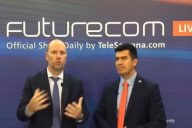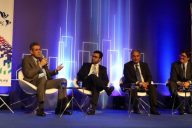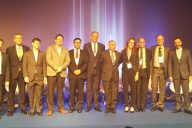Downplaying Technology in the Connected AgeDownplaying Technology in the Connected Age
0Este contenido solo está disponible en Ingles.
Every couple of generations the culture undergoes a shift so pronounced from what has come before that it earns a label of notoriety. In recent Western history, for example, the terms Gilded and Jazz have been used to label time periods featuring notable social and industrial transitions lasting a decade or more.
The current snapshot of human culture, defined by unprecedented access to information and other humansthrough inexpensive and portable devices, is already being labeled by some commentators as the Technology Age.
While there is no denying that the currentcommercial implementations of multiple technologies, including silicon and spectrum utilization, are dramatically impacting the day-to-day existence of humans, the termtechnology doesn’t accurately capture the tenor of the times we live in. The major disconnect stems from the fact that technology is purposely one step removed from the mass commercializationthat is the essence of the current age. It could even be argued that the zeitgeist didn’t get started until technology was tamed, or at least hidden behind a more fashionable and accessible facade.
Technology, after all, is still largely the domain of scientists. Those that truly revel in the complexity and deeply-detailed nature of technology are a small sampling of the species and mostly made up of men and women with the initials p-h-d after their names. Even though we in the telecommunications industry marvel at the steady flow of technology breakthroughs, we are looking at things from inside a bubble.
The masses, also known as consumers, could care less about technology. They are only interested in the benefits it brings. Simplicity and instant gratification, which have little to do with technology or science, are the two basic ingredients of mass market success. The current boon in telecommunications, exemplified by the explosive sales of smartphones and tablets, is only partially a result of scientific breakthroughs in electronics and wireless radio equipment. Mobile broadband took off only after it became simple and fast – enabling humans to connect to other humans and information sources with little more than a finger swipe.
The telecommunications industry, which is driven by technology, too often takes shortcuts when moving new services from the lab to customer catalogs. We need to understand that consumers are unimpressed by patents and the bending of the laws of physics. If the service doesn’t have practical value and an intuitive interface, it is never going to catch on.
Fortunately, every so often someone comes along, such as Steve Jobs or even Mark Zuckerberg, to remind the world that the key to mass commercialization is to start with great technology and then concentrate product development efforts on hiding its complexity from consumers.
But can even “simple” services pose complexity issues when multiplied? What happens when consumers are flooded with multiple services that are compelling and in most cases required to maintain connectivity with an ever-widening circle of virtual acquaintances? While successful social networking sites are by nature simple to use and offer immediate gratification, most are designed to function in a closed universe. The result is that the average consumer now has an unmanageable number of “simple” tools for connecting with other humans and information. Call it a sort of collective complexity, but when consumers must incorporate multiple communications and networking systems into their everyday communications, simplicity goes out thewindow.
The same situation applies to subscriber devices. The crossover between smartphone and tablet users in the US is better than 25%. And, it’s a pretty safe bet that those same subscribers own a PC and at least one television hooked to a Set Top Box. When subscribers need to take note of technology-related minutia, such as OS type, pixel density and hand-offs between access networks and social networking sites, mass commercialization comes to a screeching halt.
This situation has created a rare opportunity for operators. By owning the network, which is the common denominator connecting social networking sites, devices and operating systems, only the operator is capable of clearing up the increasing chaos that is the average subscriber’s communications experience.
By working with equipment and software makers – such as GENBAND – who offer cloud-based address books and the ability to control all forms of communications from a single application available on any device, operators can seize the mantle of simplicity and instant gratification that is crucial to commercial success.
As operators embrace the notion that we are now living in the Connected Age, rather than the Technology Age, the fight for customer loyalty is increasingly winnable.
Este conteúdo está disponível somente em inglês.
Every couple of generations the culture undergoes a shift so pronounced from what has come before that it earns a label of notoriety. In recent Western history, for example, the terms Gilded and Jazz have been used to label time periods featuring notable social and industrial transitions lasting a decade or more.
The current snapshot of human culture, defined by unprecedented access to information and other humansthrough inexpensive and portable devices, is already being labeled by some commentators as the Technology Age.
While there is no denying that the currentcommercial implementations of multiple technologies, including silicon and spectrum utilization, are dramatically impacting the day-to-day existence of humans, the termtechnology doesn’t accurately capture the tenor of the times we live in. The major disconnect stems from the fact that technology is purposely one step removed from the mass commercializationthat is the essence of the current age. It could even be argued that the zeitgeist didn’t get started until technology was tamed, or at least hidden behind a more fashionable and accessible facade.
Technology, after all, is still largely the domain of scientists. Those that truly revel in the complexity and deeply-detailed nature of technology are a small sampling of the species and mostly made up of men and women with the initials p-h-d after their names. Even though we in the telecommunications industry marvel at the steady flow of technology breakthroughs, we are looking at things from inside a bubble.
The masses, also known as consumers, could care less about technology. They are only interested in the benefits it brings. Simplicity and instant gratification, which have little to do with technology or science, are the two basic ingredients of mass market success. The current boon in telecommunications, exemplified by the explosive sales of smartphones and tablets, is only partially a result of scientific breakthroughs in electronics and wireless radio equipment. Mobile broadband took off only after it became simple and fast – enabling humans to connect to other humans and information sources with little more than a finger swipe.
The telecommunications industry, which is driven by technology, too often takes shortcuts when moving new services from the lab to customer catalogs. We need to understand that consumers are unimpressed by patents and the bending of the laws of physics. If the service doesn’t have practical value and an intuitive interface, it is never going to catch on.
Fortunately, every so often someone comes along, such as Steve Jobs or even Mark Zuckerberg, to remind the world that the key to mass commercialization is to start with great technology and then concentrate product development efforts on hiding its complexity from consumers.
But can even “simple” services pose complexity issues when multiplied? What happens when consumers are flooded with multiple services that are compelling and in most cases required to maintain connectivity with an ever-widening circle of virtual acquaintances? While successful social networking sites are by nature simple to use and offer immediate gratification, most are designed to function in a closed universe. The result is that the average consumer now has an unmanageable number of “simple” tools for connecting with other humans and information. Call it a sort of collective complexity, but when consumers must incorporate multiple communications and networking systems into their everyday communications, simplicity goes out thewindow.
The same situation applies to subscriber devices. The crossover between smartphone and tablet users in the US is better than 25%. And, it’s a pretty safe bet that those same subscribers own a PC and at least one television hooked to a Set Top Box. When subscribers need to take note of technology-related minutia, such as OS type, pixel density and hand-offs between access networks and social networking sites, mass commercialization comes to a screeching halt.
This situation has created a rare opportunity for operators. By owning the network, which is the common denominator connecting social networking sites, devices and operating systems, only the operator is capable of clearing up the increasing chaos that is the average subscriber’s communications experience.
By working with equipment and software makers – such as GENBAND – who offer cloud-based address books and the ability to control all forms of communications from a single application available on any device, operators can seize the mantle of simplicity and instant gratification that is crucial to commercial success.
As operators embrace the notion that we are now living in the Connected Age, rather than the Technology Age, the fight for customer loyalty is increasingly winnable.













